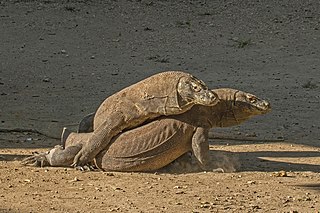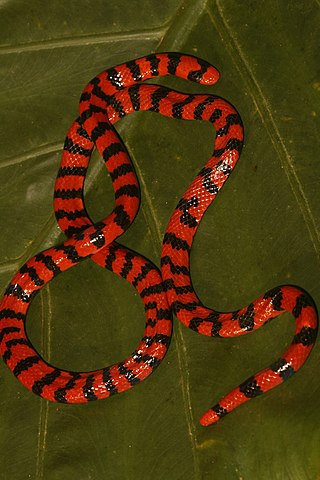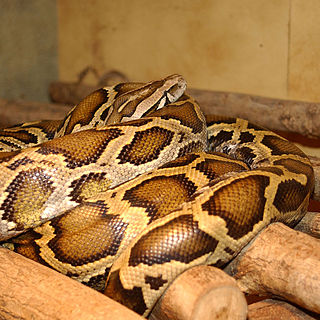
The Pythonidae, commonly known as pythons, are a family of nonvenomous snakes found in Africa, Asia, and Australia. Among its members are some of the largest snakes in the world. Ten genera and 39 species are currently recognized. Being naturally non-venomous, pythons must constrict their prey to induce cardiac arrest prior to consumption. Pythons will typically strike at and bite their prey of choice to gain hold of it; they then must use physical strength to constrict their prey, by coiling their muscular bodies around the animal, effectively suffocating it before swallowing whole. This is in stark contrast to venomous snakes such as the rattlesnake, for example, which delivers a swift, venomous bite but releases, waiting as the prey succumbs to envenomation before being consumed. Collectively, the pythons are well-documented and studied as constrictors, much like other non-venomous snakes, including the boas and even kingsnakes of the New World.

The family Psittacidae or holotropical parrots is one of three families of true parrots. It comprises the 12 species of subfamily Psittacinae and 167 of subfamily Arinae including several species that have gone extinct in recent centuries. Some of the most iconic birds in the world are represented here, such as the blue-and-yellow macaw among the New World parrots and the grey parrot among the Afrotropical parrots.

The Boidae, commonly known as boas or boids, are a family of nonvenomous snakes primarily found in the Americas, as well as Africa, Europe, Asia, and some Pacific islands. Boas include some of the world's largest snakes, with the green anaconda of South America being the heaviest and second-longest snake known; in general, adults are medium to large in size, with females usually larger than the males. Six subfamilies comprising 15 genera and 54 species are currently recognized.

The Varanidae are a family of lizards in the superfamily Varanoidea and order Anguimorpha. The family, a group of carnivorous and frugivorous lizards, includes the living genus Varanus and a number of extinct genera more closely related to Varanus than to the earless monitor lizard (Lanthanotus). Varanus includes the Komodo dragon, crocodile monitor, savannah monitor, the goannas of Australia and Southeast Asia, and various other species with a similarly distinctive appearance. Their closest living relatives are the earless monitor lizard and Chinese crocodile lizard. The oldest members of the family are known from the Late Cretaceous of Mongolia.

Anomochilidae is a family of snakes with one genus, Anomochilus, containing three species of snake. Members of the genus are known as anomochilids, or by the common names dwarf pipesnakes, lesser pipesnakes, and giant blind snakes. Initially created as Anomalochilus in 1890 for the species A. weberi, the genus was renamed in 1901 because the original name was already in use for a genus of beetles. Dwarf pipesnakes are small and cylindrical, with short, conical tails and small, rounded heads that are continuous with the neck. They have blackish to purplish-brown uppersides and dark brown or black undersides, with orange-red bands around the tail and a variety of pale markings on the snout and belly. All three species of dwarf pipesnake are endemic to Sundaland, where they are found on the Malay Peninsula and the islands of Sumatra and Borneo.

Caniformia is a suborder within the order Carnivora consisting of "dog-like" carnivorans. They include dogs, bears, raccoons, and mustelids. The Pinnipedia are also assigned to this group. The center of diversification for the Caniformia is North America and northern Eurasia. Caniformia stands in contrast to the other suborder of Carnivora, the Feliformia, the center of diversification of which was in Africa and southern Asia.

The Aniliidae are a monotypic family created for the monotypic genus Anilius that contains the single species Anilius scytale. Common names include the American pipe snake and false coral snake. It is found in South America. This snake possesses a vestigial pelvic girdle that is visible as a pair of cloacal spurs. It is ovoviviparous. It is non-venomous, and its diet consists mainly of amphibians and other reptiles. Two subspecies are recognized, including the nominate subspecies described here.
The Uropeltidae, also commonly known as shield-tail snakes, shield-tailed snakes or earth snakes, are a family of primitive, nonvenomous, burrowing snakes native to Peninsular India and Sri Lanka. The name is derived from the Greek words ura ('tail') and pelte ('shield'), indicating the presence of the large keratinous shield at the tip of the tail. Seven or eight genera are recognized, depending on whether Teretrurus rhodogaster is treated in its own genus or as part of Brachyophidium. The family comprises over 50 species. These snakes are not well known in terms of their diversity, biology, and natural history.

Henophidia is a former superfamily of the suborder Serpentes (snakes) that contains boas, pythons and numerous other less-well-known snakes.

The Cylindrophiidae are a monotypic family of secretive, semifossorial, non-venomous snakes containing the genus Cylindrophis found in southeastern Asia. These are burrowing snakes and most have a banded pattern on the belly. Currently, 14 species are recognized, all with no subspecies. Common names include Asian pipesnakes and Asian cylinder snakes.

The Calabar python is a species of non-venomous snake in the family Boidae. The species is endemic to West and Central Africa. It is the only species in its genus.

Pelvic spurs are external protrusions found around the cloaca in certain superfamilies of snakes belonging to the greater infraorder Alethinophidia. These spurs are made up of the remnants of the femur bone, which is then covered by a corneal spur, or claw-like structure. This femur derives from ancestral hind limbs found in the most recent common ancestor of modern snakes and the other reptiles of the clade Toxicofera, many of which have fully functional front and hind limbs. Due to the fact that the spurs derive from the ancestral state of functional legs, but are no longer functional for locomotion specifically, these structures meet the criteria for being considered vestigial. Nonetheless, uses for the structures have been thoroughly documented. Species that have external spurs have corresponding muscles, neurological structures, and vascularization to allow for independent movement. The spurs are more pronounced and visible in male specimens and have been observed in use during courtship behavior. The spurs are specifically used in the clasping and stimulation of females by males during courtship and mating. In certain species, males will also use their spurs to engage in combat with one another.

The Alethinophidia are an infraorder of snakes that includes all snakes other than blind snakes and thread snakes. Snakes have long been grouped into families within Alethinophidia based on their morphology, especially that of their teeth. More modern phylogenetic hypotheses using genetic data support the recognition of 19 extant families, although the taxonomy of alethinophidian snakes has long been debated, and ultimately the decision whether to assign a particular clade to a particular Linnaean rank is arbitrary.
The Pythonoidea, also known as pythonoid snakes, are a superfamily of snakes that contains pythons and other closely related python-like snakes. As of 2022, Pythonoidea contains 39 species, including the eponymous genus Python and 10 other genera of pythons, all in the family Pythonidae, as well as two lesser-known families, Loxocemidae and Xenopeltidae.

Anomochilus monticola, the Kinabalu giant blind snake, mountain pipe snake, or Mount Kinabalu dwarf pipesnake, is a species of snake in the dwarf pipesnake family Anomochilidae. It is endemic to Kinabalu Park in northern Borneo, where it inhabits montane and submontane rainforest at altitudes of 1,450–1,513 m (4,757–4,964 ft). Described by the herpetologist Indraneil Das and colleagues in 2008, the species is a stout, cylindrical snake with a small head and short, conical tail. It is the largest species in its genus, with a total length of 521 mm (20.5 in). It is mostly iridescent blue-black in color, with a deep brown belly, large pale horn-colored blotches along the underside, a chrome orange band around the tail, a pale creamy-yellow bar across the snout, and pale horn-colored speckles along its sides. It can be told apart from the other species in its genus by its large size, the absence of a stripe along its sides, and the lack of pale blotches on its back.

Malayopython is a genus of constricting snakes in the family Pythonidae. The genus is native to India and Southeast Asia. It contains two species, both of which were previously classified within the genus Python. However, multiple studies recovered these species as distinct. Known as the "reticulatus clade", it was eventually found to be a sister lineage to a lineage giving rise to the Indo-Australian pythons rather than the genus Python.

The Booidea, also known as booid snakes, are a superfamily of snakes that contains boas and other closely related boa-like snakes. As of 2017, Booidea contains 61 species, including the eponymous neotropical Boa constrictor, anacondas, and smaller tree and rainbow boas as well as several genera of booid snakes from various locations around the world: bevel-nosed boas or keel-scaled boas (Candoia) from New Guinea and Melanesia, Old World sand boas (Eryx) from Northeast Africa, the Middle East, and Southwest Asia, rubber boas (Charina) and rosy boas (Lichanura) from North America, neotropical dwarf boas (Ungaliophis) and the Oaxacan dwarf boa (Exiliboa) from Central America, Madagascan boas or Malagasy boas from Madagascar, and the Calabar python (Calabaria) from tropical West-Central Africa.

The Amerophidia, also known as amerophidian snakes, are a clade of snakes that contains two families: Aniliidae and the boa-like Tropidophiidae.

The Colubroides are a clade in the suborder Serpentes (snakes). It contains over 85% of all the extant species of snakes. The largest family is Colubridae, but it also includes at least six other families, at least four of which were once classified as "Colubridae" before molecular phylogenetics helped in understanding their relationships. It has been found to be monophyletic.
















